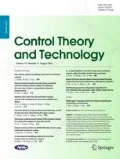Abstract
For vehicle adaptive cruise control (ACC) systems, the switching performance between throttle and brake determines the driving comfort, fuel consumption and service lives of vehicle mechanical components. In this paper, an ACC algorithm with the optimal switching control between throttle and brake is designed in model predictive control (MPC) framework. By introducing the binary integer variables, the dynamics of throttle and brake are integrated in one model expression for the controller design. Then the ACC algorithm is designed to satisfy not only safe car following, but also the optimal switching between throttle and brake, which leads to an online mixed integer quadratic programming solved by the nested two-loop method. The simulation results show that the proposed ACC algorithm meets the requirements of safe car following, outperforms the traditional algorithms by performing smoother responses, reducing the switching times between throttle and brake, and therefore improves driving comfort and fuel efficiency significantly.
Similar content being viewed by others
References
A. Vahidi, A. Eskandarian. Research advances in intelligent collision avoidance and adaptive cruise control. IEEE Transactions on Intelligent Transportation Systems, 2003, 4(3): 143–153.
L. Xiao, G. Feng. A comprehensive review of development of adaptive cruise control systems. Vehicle System Dynamics, 2010, 48(10): 1167–1192.
R. Rajamani. Vehicle Dynamics and Control. New York: Springer, 2006: 153–181.
J. C. Gerdes, J. K. Hedrick. Vehicle speed and spacing control via coordinated throttle and brake actuation. Control Engineer Practice, 1997, 5(11): 1607–1614.
Y. Zhang, E. B. Kosmatopoulos, P. A. Ioannou, et al. Autonomous intelligent cruise control using front and back information for tight vehicle following maneuvers. IEEE Transactions on Vehicular Technology, 1999, 48(1): 319–328.
J. Karl Hedrick, X. Y. Lu. Heavy-duty vehicle modeling and longitudinal contro. Vehicle System Dynamics, 2005, 43(9): 653–669.
P. Ioannou, Z. Xu, S. Eckert, et al. Intelligent cruise control: theory and experiment. Proceedings of the 32nd IEEE Conference on Decision and Control. San Antonlo: IEEE, 1993: 1885–1890.
S. N. Huang, W. Ren. Vehicle longitudinal control using throttles and brakes. Robotics and Autonomous Systems, 1999, 26(4): 241–253.
W. Beak, B. Song. Design and validation of a longitudinal via velocity and distance controller via hardware-in-the-loop simulation. International Journal of Automotive Technology, 2009, 10(1): 95–102.
D. Swaroop, K. R. Rajagopal. A review of constant time headway policy for automatic vehicle following. IEEE Intelligent Transportation Systems Conference, 2001: 65–69.
Y. Kyongsu, J. Chung. Nonlinear brake control for vehicle CW/CA systems. IEEE/ASME Transactions on Mechatronics, 2001, 6(1): 17–25.
C. E. Garcia, D. M. Prett, M. Morari. Model predictive control theory and practice—A survey. Automatica, 1989, 25(3): 335–348.
A. Beccuti, T. Geyer, M. Morari. A hybrid system approach to power systems voltage control. Proceedings of the 44th IEEE Conference Decision Control. Seville: IEEE, 2005: 6774–6779.
X. Chen, Z. Li, J. Yang, et al. Nested tabu search (TS) and sequential quadratic programming (SQP) method, combined with adaptive model reformulation for heat exchanger network synthesis. Industrial and Engineering Chemistry Research, 2008, 47(7): 2320–2330.
M. Clerc, J. Kennedy. The particle swarm-explosion, stability, and convergence in a multidimensional complex space. IEEE Transactions on Evolutionary Computation, 2002, 6(1): 58–73.
Y. Del Valle, G. K Venayagamoorthy, S. Mohagheghi, et al. Particle swarm optimization: Basic concepts, variants and applications in power systems. IEEE Transactions on Evolutionary Computation, 2008, 12(2): 171–195.
S. Boyd, L. Vandenberghe. Convex Optimization. New York: Cambridge University, 2004.
M. Barth, G. Scora, T. Younglove. Modal emissions model for heavyduty diesel vehicles. The 83rd Annual Meeting of the Transportation-Research-Board. Washington, DC: TRB, 2004: 10–20.
V. L. Baghwar, W. L Garrard, R. Rajamani. Model predictive control of transitional maneuvers for adaptive cruise control vehicles. IEEE Transactions on Vehicular Technology, 2004, 53(5): 1573–1585.
Author information
Authors and Affiliations
Corresponding author
Additional information
This work was supported by Science & Technology Program of Shanghai Maritime University (No. 20120077).
Lihua LUO received her B.S. degree in Electrical Engineering and Automation from Xidian University in 2006, and was recommended to Zhejiang University to purse the Ph.D. degree at the same year. She received Ph.D. degree in Control Science and Engineering in 2011. Currently, she is a lecturer in the college of Transport and Communication in Shanghai Maritime University. Her research includes vehicle adaptive cruise control, traffic flow modeling and parameters calibration.
Ping LI received his Ph.D. degree in Industry Automation from Zhejiang University in 1988. From 1988 to 1990, he was a post doctor in Laboratory of Mechanical Fluid Power Driven and Control of Zhejiang University. From 1995 to 1996, he joined in University of British Columbia (UBC) as a senior visiting scholar. He obtained the honor of ‘Chinese Doctor with outstanding contribution’ from State Education Commission and Academic Degree Commission of State Council in 1990. Currently, he is a professor in Zhejiang University. His research includes modeling, control and optimization of complex system, intelligent transportation system, navigation and control of micro-unmanned helicopters.
HuiWANG received her B.S. degree and M.S. degree in Automation from Zhejiang University in 1982 and 1988, respectively. From 1989, She joined in Zhejiang University, and became a professor in 2002. Her research includes intelligent transportation system, modeling and optimization of complicated industry, and application of computer control system.
Rights and permissions
About this article
Cite this article
Luo, L., Li, P. & Wang, H. Vehicle adaptive cruise control design with optimal switching between throttle and brake. J. Control Theory Appl. 10, 426–434 (2012). https://doi.org/10.1007/s11768-012-0319-0
Received:
Revised:
Published:
Issue Date:
DOI: https://doi.org/10.1007/s11768-012-0319-0



